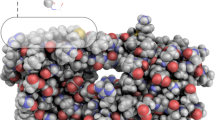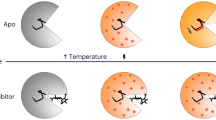Abstract
The synergy between structure and dynamics is essential to the function of biological macromolecules. Thermally driven dynamics on different timescales have been experimentally observed or simulated, and a direct link between micro- to milli-second domain motions and enzymatic function has been established1,2,3,4. However, very little is understood about the connection of these functionally relevant, collective movements with local atomic fluctuations, which are much faster. Here we show that pico- to nano-second timescale atomic fluctuations in hinge regions of adenylate kinase facilitate the large-scale, slower lid motions that produce a catalytically competent state. The fast, local mobilities differ between a mesophilic and hyperthermophilic adenylate kinase, but are strikingly similar at temperatures at which enzymatic activity and free energy of folding are matched. The connection between different timescales and the corresponding amplitudes of motions in adenylate kinase and their linkage to catalytic function is likely to be a general characteristic of protein energy landscapes.
This is a preview of subscription content, access via your institution
Access options
Subscribe to this journal
Receive 51 print issues and online access
$199.00 per year
only $3.90 per issue
Buy this article
- Purchase on Springer Link
- Instant access to full article PDF
Prices may be subject to local taxes which are calculated during checkout




Similar content being viewed by others
References
Wolf-Watz, M. et al. Linkage between dynamics and catalysis in a thermophilic-mesophilic enzyme pair. Nature Struct. Mol. Biol. 11, 945–949 (2004)
Boehr, D. D., Dyson, H. J. & Wright, P. E. An NMR perspective on enzyme dynamics. Chem. Rev. 106, 3055–3079 (2006)
Austin, R. H., Beeson, K. W., Eisenstein, L., Frauenfelder, H. & Gunsalus, I. C. Dynamics of ligand binding to myoglobin. Biochemistry 14, 5355–5373 (1975)
Henzler-Wildman, K. et al. Intrinsic motions along an enzymatic reaction trajectory. Nature advanced online publication. doi: 10.1030/nature06410 (18 November 2007)
Vitkup, D., Ringe, D., Petsko, G. A. & Karplus, M. Solvent mobility and the protein 'glass' transition. Nature Struct. Biol. 7, 34–38 (2000)
Fenimore, P. W., Frauenfelder, H., McMahon, B. H. & Parak, F. G. Slaving: Solvent fluctuations dominate protein dynamics and functions. Proc. Natl Acad. Sci. USA 99, 16047–16051 (2002)
Nagel, Z. D. & Klinman, J. P. Tunneling and dynamics in enzymatic hydride transfer. Chem. Rev. 106, 3095–3118 (2006)
Hollien, J. & Marqusee, S. Structural distribution of stability in a thermophilic enzyme. Proc. Natl Acad. Sci. USA 96, 13674–13678 (1999)
Butterwick, J. A. et al. Multiple time scale backbone dynamics of homologous thermophilic and mesophilic ribonuclease HI enzymes. J. Mol. Biol. 339, 855–871 (2004)
Cole, R. & Loria, J. P. FAST-Modelfree: A program for rapid automated analysis of solution NMR spin-relaxation data. J. Biomol. NMR 26, 203–213 (2003)
Lipari, G. & Szabo, A. Model-free approach to the interpretation of nuclear magnetic resonance relaxation in macromolecules. 1. Theory and range of validity. J. Am. Chem. Soc. 104, 4546–4559 (1982)
Mandel, A. M., Akke, M. & Palmer, A. G. Backbone dynamics of Escherichia coli ribonuclease H—correlations with structure and function in an active enzyme. J. Mol. Biol. 246, 144–163 (1995)
Monnot, M. et al. Circular-dichroism investigation of Escherichia coli adenylate kinase. J. Biol. Chem. 262, 2502–2506 (1987)
Mandel, A. M., Akke, M. & Palmer, A. G. Dynamics of ribonuclease H: Temperature dependence of motions on multiple time scales. Biochemistry 35, 16009–16023 (1996)
Petsko, G. A. Structural basis of thermostability in hyperthermophilic proteins, or “there's more than one way to skin a cat”. Methods Enzymol. 334, 469–478 (2001)
Bae, E. & Phillips, G. N. Roles of static and dynamic domains in stability and catalysis of adenylate kinase. Proc. Natl Acad. Sci. USA 103, 2132–2137 (2006)
Zhang, F. L. & Bruschweiler, R. Contact model for the prediction of NMR 15N-1H order parameters in globular proteins. J. Am. Chem. Soc. 124, 12654–12655 (2002)
Jacobs, D. J., Rader, A. J., Kuhn, L. A. & Thorpe, M. F. Protein flexibility predictions using graph theory. Proteins 44, 150–165 (2001)
Halle, B. Flexibility and packing in proteins. Proc. Natl Acad. Sci. USA 99, 1274–1279 (2002)
Maragakis, P. & Karplus, M. Large amplitude conformational change in proteins explored with a plastic network model: Adenylate kinase. J. Mol. Biol. 352, 807–822 (2005)
Clore, G. M. & Schweiters, C. D. Concordance of residual dipolar coupling, backbone order parameters and crystallographic B-factors for a small α/β protein: A unified picture of high probability, fast atomic motions in proteins. J. Mol. Biol. 355, 879–886 (2006)
Lou, H. F. & Cukier, R. I. Molecular dynamics of apo-adenylate kinase: A principal component analysis. J. Phys. Chem. B 110, 12796–12808 (2006)
Prompers, J. J. & Bruschweiler, R. Thermodynamic interpretation of NMR relaxation parameters in proteins in the presence of motional correlations. J. Phys. Chem. B 104, 11416–11424 (2000)
Temiz, N. A., Meirovitch, E. & Bahar, I. Escherichia coli adenylate kinase dynamics: Comparison of elastic network model modes with mode-coupling 15N-NMR relaxation data. Proteins 57, 468–480 (2004)
Miyashita, O., Onuchic, J. N. & Wolynes, P. G. Nonlinear elasticity, proteinquakes, and the energy landscapes of functional transitions in proteins. Proc. Natl Acad. Sci. USA 100, 12570–12575 (2003)
Karplus, M. & Mccammon, J. A. The internal dynamics of globular-proteins. CRC Crit. Rev. Biochem. 9, 293–349 (1981)
Brooks, B. R. et al. CHARMM - a program for macromolecular energy, minimization, and dynamics calculations. J. Comp. Chem. 4, 187–217 (1983)
Chenna, R. et al. Multiple sequence alignment with the Clustal series of programs. Nucleic Acids Res. 31, 3497–3500 (2003)
Koradi, R., Billeter, M. & Wuthrich, K. MOLMOL: A program for display and analysis of macromolecular structures. J. Mol. Graph. 14, 51–55 29–32 (1996)
Karplus, M. & Kushick, J. N. Method for Estimating the Configurational Entropy of Macromolecules. Macromolecules 14, 325–332 (1981)
Lee, A. L. & Wand, A. J. Assessing potential bias in the determination of rotational correlation times of proteins by NMR relaxation. J. Biomol. NMR 13, 101–112 (1999)
Buck, M., Bouguet-Bonnet, S., Pastor, R. W. & MacKerell, A. D. Importance of the CMAP correction to the CHARMM22 protein force field: Dynamics of hen lysozyme. Biophys. J. 90, L36–L38 (2006)
Shapiro, Y. E. et al. Domain flexibility in ligand-free and inhibitor-bound Escherichia coli adenylate kinase based on a mode-coupling analysis of N-15 spin relaxation. Biochemistry 41, 6271–6281 (2002)
Tugarinov, V., Shapiro, Y. E., Liang, Z. C., Freed, J. H. & Meirovitch, E. A novel view of domain flexibility in E. coli adenylate kinase based on structural mode-coupling 15N NMR relaxation. J. Mol. Biol. 315, 155–170 (2002)
Hall, J. B. & Fushman, D. Characterization of the overall and local dynamics of a protein with intermediate rotational anisotropy: Differentiating between conformational exchange and anisotropic diffusion in the B3 domain of protein G. J. Biomol. NMR 27, 261–275 (2003)
Bernado, P., de la Torre, J. G. & Pons, M. Interpretation of 15N NMR relaxation data of globular proteins using hydrodynamic calculations with HYDRONMR. J. Biomol. NMR 23, 139–150 (2002)
de la Torre, J. G., Huertas, M. L. & Carrasco, B. HYDRONMR: Prediction of NMR relaxation of globular proteins from atomic-level structures and hydrodynamic calculations. J. Magn. Reson. 147, 138–146 (2000)
Evenas, J., Forsen, S., Malmendal, A. & Akke, M. Backbone dynamics and energetics of a calmodulin domain mutant exchanging between closed and open conformations. J. Mol. Biol. 289, 603–617 (1999)
Seewald, M. J. et al. The role of backbone conformational heat capacity in protein stability: Temperature dependent dynamics of the B1 domain of Streptococcal protein G. Protein Sci. 9, 1177–1193 (2000)
Spyracopoulos, L. et al. Temperature dependence of dynamics and thermodynamics of the regulatory domain of human cardiac troponin C. Biochemistry 40, 12541–12551 (2001)
Zhuravleva, A. V. et al. Gated electron transfers and electron pathways in azurin: A NMR dynamic study at multiple fields and temperatures. J. Mol. Biol. 342, 1599–1611 (2004)
Chang, S. L. & Tjandra, N. Temperature dependence of protein backbone motion from carbonyl 13C and amide 15N NMR relaxation. J. Magn. Reson. 174, 43–53 (2005)
Wang, T. Z., Cai, S. & Zuiderweg, E. R. P. Temperature dependence of anisotropic protein backbone dynamics. J. Am. Chem. Soc. 125, 8639–8643 (2003)
Vugmeyster, L., Raleigh, D. P., Palmer, A. G. & Vugmeister, B. E. Beyond the decoupling approximation in the model free approach for the interpretation of NMR relaxation of macromolecules in solution. J. Am. Chem. Soc. 125, 8400–8404 (2003)
Bracken, C., Carr, P. A., Cavanagh, J. & Palmer, A. G. Temperature dependence of intramolecular dynamics of the basic leucine zipper of GCN4: Implications for the entropy of association with DNA. J. Mol. Biol. 285, 2133–2146 (1999)
Zhang, Q., Sun, X. Y., Watt, E. D. & Al-Hashimi, H. M. Resolving the motional modes that code for RNA adaptation. Science 311, 653–656 (2006)
Hayward, S. & Lee, R. A. Improvements in the analysis of domain motions in proteins from conformational change: DynDom version 1.50. J. Mol. Graph. Model. 21, 181–183 (2002)
Acknowledgements
We thank L. Kay for providing pulse programs. We are grateful to K. O. Stetter for providing DNA isolated from Aquifex aeolicus and the Advanced Biomedical Computing Center for CPU hours. This work was supported by NIH grants (D.K. and K.A.H.-W.), a DOE grant (D.K.) and a fellowship from the American Heart Association (M.L.). The research at Harvard was supported in part by a grant from NIH to M.K.
Author Contributions K.A.H.-W. and M.L. contributed equally to this work. K.A.H.-W. performed the NMR experiments with supervision from D.K., and M.L. carried out the computational analysis with supervision from M.K. and D.K. All authors discussed the results and interpretation. D.K. and K.A.H.-W. wrote the manuscript.
Author information
Authors and Affiliations
Corresponding author
Supplementary information
Supplementary Information
The file contains Supplementary Discussion with additional references, Supplementary Tables S1-S4 and Supplementary Figures S1-S13 with Legends. (PDF 3255 kb)
Supplementary Figure S11
The file contains Supplementary Figure S11 at higher resolution for readability. (PDF 640 kb)
Rights and permissions
About this article
Cite this article
Henzler-Wildman, K., Lei, M., Thai, V. et al. A hierarchy of timescales in protein dynamics is linked to enzyme catalysis. Nature 450, 913–916 (2007). https://doi.org/10.1038/nature06407
Received:
Accepted:
Published:
Issue Date:
DOI: https://doi.org/10.1038/nature06407
This article is cited by
-
Allosteric activation unveils protein-mass modulation of ATP phosphoribosyltransferase product release
Communications Chemistry (2024)
-
Small molecule branched-chain ketoacid dehydrogenase kinase (BDK) inhibitors with opposing effects on BDK protein levels
Nature Communications (2023)
-
Cross-scale analysis of temperature compensation in the cyanobacterial circadian clock system
Communications Physics (2022)
-
Acceleration of enzymatic catalysis by active hydrodynamic fluctuations
Communications Physics (2022)
-
Functional control of a 0.5 MDa TET aminopeptidase by a flexible loop revealed by MAS NMR
Nature Communications (2022)
Comments
By submitting a comment you agree to abide by our Terms and Community Guidelines. If you find something abusive or that does not comply with our terms or guidelines please flag it as inappropriate.



